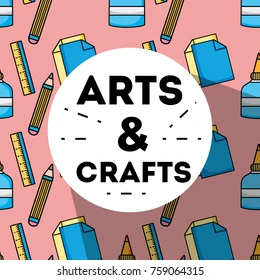Arts & Crafts

The Beauty of Art and Crafts
Art and crafts have been an essential part of human culture for centuries, serving as a means of expression, storytelling, and creativity. From ancient civilizations to modern times, handmade works of art reflect cultural heritage, emotions, and innovation. The world of art and crafts is vast, encompassing a wide range of techniques, materials, and styles, each with its own unique significance and purpose.
The Essence of Art and Crafts
Art and crafts are more than just creative endeavors; they are a testament to human ingenuity and imagination. Artists and craftsmen use their hands, tools, and minds to transform raw materials into beautiful and functional objects. Whether it is a delicate painting, an intricately woven textile, or a hand-carved wooden sculpture, each piece tells a story of its maker’s inspiration, culture, and skills.
While art is often associated with self-expression and aesthetics, crafts are usually linked to functionality and tradition. However, the two frequently overlap, resulting in creations that are both visually stunning and practical. Whether through pottery, jewelry-making, embroidery, or paper crafts, artisans infuse their work with personal touches that make each piece unique.
The History of Art and Crafts
The history of art and crafts dates back to prehistoric times when early humans created cave paintings, pottery, and tools. These early forms of artistic expression served both practical and spiritual purposes, often depicting scenes of daily life, religious beliefs, and natural surroundings. Over time, different civilizations developed their own artistic styles, influenced by geography, culture, and available materials.
In ancient Egypt, artisans crafted intricate jewelry, sculptures, and textiles, many of which were used for religious rituals and royal adornment. In medieval Europe, guilds were established to regulate and preserve the high standards of craftsmanship in trades such as metalwork, woodworking, and textiles. Similarly, in Asia, traditional crafts such as Japanese origami, Chinese silk embroidery, and Indian block printing have been practiced for centuries, each contributing to the rich artistic heritage of their respective regions.
Techniques and Materials
Art and crafts involve a wide range of techniques and materials, each chosen based on the artist’s vision and purpose. Some common forms of art and crafts include:
- Painting and Drawing – Using mediums such as watercolor, oil, acrylics, charcoal, and ink to create visual representations of the world or abstract ideas.
- Pottery and Ceramics – Shaping clay into functional or decorative objects, often fired in kilns and glazed for durability and beauty.
- Textile Arts – Weaving, knitting, crocheting, embroidery, and fabric dyeing, used to create clothing, tapestries, and home decor.
- Woodworking – Carving, shaping, and assembling wood to produce furniture, sculptures, and intricate decorative pieces.
- Metalworking and Jewelry-Making – Crafting beautiful adornments using precious metals, stones, and intricate designs.
- Paper Crafts – Origami, quilling, scrapbooking, and papermaking, transforming simple paper into artistic masterpieces.
Each technique requires patience, skill, and creativity, making the final product a reflection of the artisan’s dedication and expertise.
The Role of Art and Crafts in Society
Art and crafts hold significant cultural, economic, and therapeutic value. They provide a means of preserving traditions, supporting livelihoods, and fostering creativity. Many communities rely on traditional crafts as a source of income, with artisans selling their work through markets, exhibitions, and online platforms.
Additionally, engaging in art and crafts has been shown to have therapeutic benefits. Creative activities help reduce stress, enhance cognitive function, and provide a sense of accomplishment. Schools and community centers often incorporate arts and crafts programs to encourage self-expression, problem-solving skills, and teamwork.
The Evolution of Art and Crafts
With the advent of technology, the world of art and crafts has evolved, blending traditional methods with modern innovations. Digital art, 3D printing, and new materials have expanded the possibilities for artists and craftsmen, allowing for greater experimentation and accessibility.
Despite technological advancements, there remains a deep appreciation for handmade and unique items. Many people seek out handcrafted goods for their authenticity, quality, and the connection they provide to the artist’s story and skill. The resurgence of interest in DIY (Do-It-Yourself) culture and sustainable, handcrafted products highlights the continued relevance of traditional crafts in a fast-paced, digital world.
Supporting Art and Crafts
Supporting art and crafts is essential for preserving cultural heritage and sustaining artisan communities. Purchasing handmade items, attending craft fairs, and learning traditional techniques help keep these traditions alive. Additionally, many organizations and initiatives promote fair trade practices, ensuring that artisans receive fair wages for their work.
By appreciating and investing in handcrafted art, we contribute to a world that values creativity, tradition, and human connection. Whether as creators or admirers, art and crafts offer a way to celebrate individuality, history, and the endless possibilities of human expression.
Conclusion
Art and crafts are a vibrant and integral part of human civilization, enriching our lives with beauty, meaning, and creativity. From ancient traditions to modern innovations, the world of handmade artistry continues to inspire and connect people across cultures and generations. Whether practiced as a profession, a hobby, or a form of therapy, art and crafts remain a powerful medium of expression, storytelling, and connection in our ever-evolving world.
17 0 7
Write a Comments
* Be the first to Make Comment















